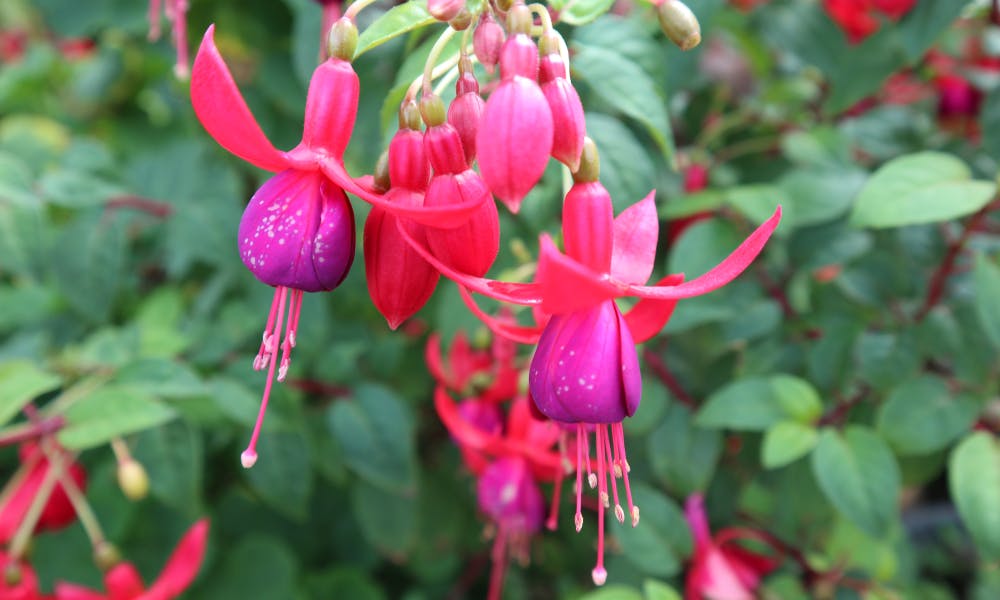MENU
Fuchsia Flower: From Origins to How to Make It Bloom

Fuchsia flowers are beautiful plants that bring life to any garden. They are categorized into more than 8,000 varieties regarding colors, sizes, and shapes. There are about 120 species of this colorful flower that are native to areas in Central and South America, New Zealand, Mexico, and Tahiti. Keep reading to find out more details about:
* The origins and etymology of fuchsia flower
* How to care for your fuchsia
* Why is my fuchsia not flowering?
* Tips to help your fuchsia bloom
The Origins and Etymology of Fuchsia
As these flowers are native to the American continent, they were brought by the first plant explorers to Europe in the 1800s. They quickly become favorites in the Victorian era and numerous species were bred together to offer variability to this flower. Some of these varieties can be everblooming, while others start earlier or later in the season.
The genus of this flower inspires the name of the flower as fuchsia, which also represents the reddish-purple color. Leonhard Fuchs was a 16th century physician and botanist who named the genus. The hanging tendency of the flower and the characteristic shape associates it with ladies’ ear drops, which is another popular name of the flower.
How to Care for Your Fuchsia Plant
These plants have extremely delicate flowers with an interesting shape. If you properly care for your plant, you can be delighted by its flowers throughout the entire summer. Here are some tips to help you care for your fuchsia:
* Make sure your plant does not have any insects. You can do so by paying attention to the connection between the leaf and the stem, as this is the most common place where insects are found.
* Do not leave your fuchsia in direct sunlight. Fuchsias love semi-sunny spaces and they can thrive in cooler temperatures since they do not enjoy strong sunshine.
* Provide sufficient water to the plant, but not too much. A large amount of water makes the roots to rot; in order to avoid this, you should check whether the pot in which you placed the fuchsia has enough drainage.
* Do not let your fuchsia outside in the cold, freezing weather. Place it either inside your house or in an enclosed area. Some varieties of fuchsia can keep blooming the entire winter if you keep them indoors; once the winter is over, you may relocate your plant.
Why Is My Fuchsia Not Flowering?
Fuchsia plants are full of blossoms when they are in the right environment. However, it is quite common to see how the fuchsia’s little flowers reduce day by day until there are no more left. This can be fixed with ease if you know what to do; one important concept worth mentioning is that this plant has flowers when it grows. More specifically, not having any new flowers means that your fuchsia plant might require pinching or cutting. By cutting or pinching the plant, you help it grow new branches that encourage flowering.
Tips to Help Your Fuchsia Bloom
In early spring, when the plant grows adequately, it is common to cut the tips of the plant in order to encourage flowering. Moreover, if you want to keep it producing flowers through the summer, you should keep pinching it. All you need to do is to cut the end of each branch, approximately 1/2 of an inch.
Once you cut or pinch your plant, you should expect flowers within six weeks. If you want to keep your plant blooming, you need to pinch it regularly in spring and summer. Otherwise, it stops blooming and the old branches adopt a leggy look. In simple words, your fuchsia cannot have any flowers on old branches; only new, growing ones.
Here are some more tips to help your fuchsia bloom from spring to fall:
* Keep cutting and pinching regularly;
* Do not place the plant in direct sunlight or very dark areas;
* Ensure that you do not water it excessively;
* Put the plant in well-draining, moist soil;
* During blooming or the growth of the plant, feed it with a balanced fertilizer.
Which Are the Most Popular Fuchsia Plants?
Fuchsias come in endless varieties and they can be used to decorate your garden or your home. Here are some ideas of beautiful fuchsias you should try:
* Fuchsia Glazioviana originates from Brazil and it can reach up to 12 feet. This makes it a great choice for decorating your place using hanging baskets or topiary. The flowers are typically abundant and reach 1 inch.
* Fuchsia Fulgens is ideal if you want a smaller plant that reaches 3-4 feet. It is a winter bloomer with tiny orange to red flowers.
* Seventh Heaven is a type of fuchsia whose flowers resemble an angel’s wings. They come in a color variety of white and pink when blossoming. They are very attractive to both hummingbirds and butterflies.
* “Lady in Black” is a type of fuchsia that has an intricate flower pattern with a climbing habit. While other types of fuchsia have a habit of trailing, this makes a great addition to your garden if you want some variety. Make sure you offer it a fence or a mesh to climb.
* Dollar Princess fuchsia is a great choice if you live in colder climates, as it can withstand winter temperatures down to five degrees. It thrives when it is placed in raised beds, especially if you leave it outside over the winter. It does not enjoy wet and soggy winter soil because it can make the roots rot and die.
Overall, fuchsias are beautiful plants that are a great addition to any garden. Countless varieties offer a mix of versatility, beauty, but also resistance, making them the perfect decorations for both hot and cold climates.

